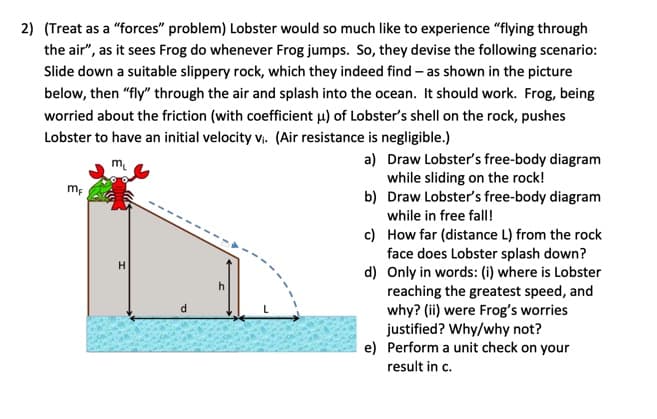(Treat as a "forces" problem) Lobster would so much like to experience "flying through the air", as it sees Frog do whenever Frog jumps. So, they devise the following scenario: Slide down a suitable slippery rock, which they indeed find - as shown in the picture below, then "fly" through the air and splash into the ocean. It should work. Frog, being worried about the friction (with coefficient u) of Lobster's shell on the rock, pushes Lobster to have an initial velocity vi. (Air resistance is negligible.) a) Draw Lobster's free-body diagram
(Treat as a "forces" problem) Lobster would so much like to experience "flying through the air", as it sees Frog do whenever Frog jumps. So, they devise the following scenario: Slide down a suitable slippery rock, which they indeed find - as shown in the picture below, then "fly" through the air and splash into the ocean. It should work. Frog, being worried about the friction (with coefficient u) of Lobster's shell on the rock, pushes Lobster to have an initial velocity vi. (Air resistance is negligible.) a) Draw Lobster's free-body diagram
Physics for Scientists and Engineers, Technology Update (No access codes included)
9th Edition
ISBN:9781305116399
Author:Raymond A. Serway, John W. Jewett
Publisher:Raymond A. Serway, John W. Jewett
Chapter5: The Laws Of Motion
Section: Chapter Questions
Problem 5.20CQ: Balancing carefully, three boys inch out onto a horizontal tree branch above a pond, each planning...
Related questions
Topic Video
Question
Hello,
Can someone please show how to solve parts d and e please?
Thank you

Transcribed Image Text:2) (Treat as a "forces" problem) Lobster would so much like to experience "flying through
the air", as it sees Frog do whenever Frog jumps. So, they devise the following scenario:
Slide down a suitable slippery rock, which they indeed find - as shown in the picture
below, then "fly" through the air and splash into the ocean. It should work. Frog, being
worried about the friction (with coefficient u) of Lobster's shell on the rock, pushes
Lobster to have an initial velocity v₁. (Air resistance is negligible.)
mF
H
d
h
a) Draw Lobster's free-body diagram
while sliding on the rock!
Draw Lobster's free-body diagram
while in free fall!
c)
How far (distance L) from the rock
face does Lobster splash down?
d) Only in words: (i) where is Lobster
reaching the greatest speed, and
why? (ii) were Frog's worries
justified? Why/why not?
e) Perform a unit check on your
result in c.
b)
Expert Solution
This question has been solved!
Explore an expertly crafted, step-by-step solution for a thorough understanding of key concepts.
Step by step
Solved in 2 steps with 1 images

Knowledge Booster
Learn more about
Need a deep-dive on the concept behind this application? Look no further. Learn more about this topic, physics and related others by exploring similar questions and additional content below.Recommended textbooks for you

Physics for Scientists and Engineers, Technology …
Physics
ISBN:
9781305116399
Author:
Raymond A. Serway, John W. Jewett
Publisher:
Cengage Learning

University Physics Volume 1
Physics
ISBN:
9781938168277
Author:
William Moebs, Samuel J. Ling, Jeff Sanny
Publisher:
OpenStax - Rice University

Classical Dynamics of Particles and Systems
Physics
ISBN:
9780534408961
Author:
Stephen T. Thornton, Jerry B. Marion
Publisher:
Cengage Learning

Physics for Scientists and Engineers, Technology …
Physics
ISBN:
9781305116399
Author:
Raymond A. Serway, John W. Jewett
Publisher:
Cengage Learning

University Physics Volume 1
Physics
ISBN:
9781938168277
Author:
William Moebs, Samuel J. Ling, Jeff Sanny
Publisher:
OpenStax - Rice University

Classical Dynamics of Particles and Systems
Physics
ISBN:
9780534408961
Author:
Stephen T. Thornton, Jerry B. Marion
Publisher:
Cengage Learning

College Physics
Physics
ISBN:
9781938168000
Author:
Paul Peter Urone, Roger Hinrichs
Publisher:
OpenStax College

Physics for Scientists and Engineers with Modern …
Physics
ISBN:
9781337553292
Author:
Raymond A. Serway, John W. Jewett
Publisher:
Cengage Learning

Physics for Scientists and Engineers
Physics
ISBN:
9781337553278
Author:
Raymond A. Serway, John W. Jewett
Publisher:
Cengage Learning